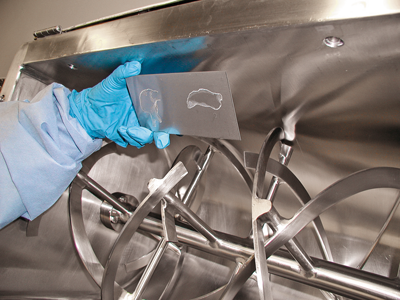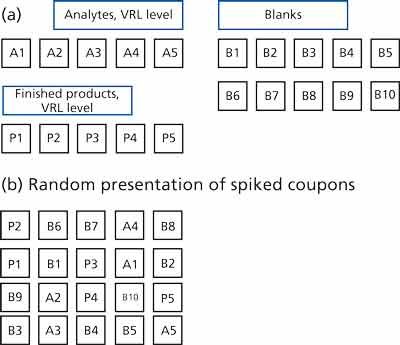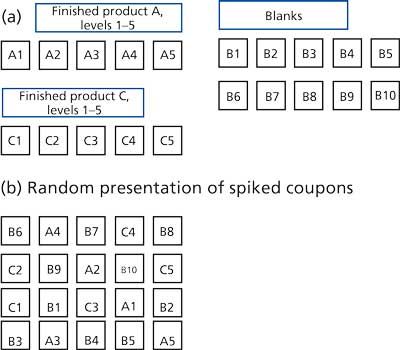Qualifying Personnel to Visually Inspect Cleaned Equipment
Different approaches for qualification of personnel for visual inspection of residues on equipment surfaces are reviewed.

Visual inspection of pharmaceutical manufacturing equipment for cleanliness is required after cleaning procedures are completed and is a prerequisite for the start of manufacturing activities (1). Cleaning validation demonstrates that the cleaning procedure reliably and consistently cleans pharmaceutical manufacturing equipment to an acceptable level. Visual inspection is an active observation of the visually accessible product contact surfaces of the pharmaceutical manufacturing equipment. The visual inspection must determine that the equipment is free from any visible residues for the cleaning to be considered adequate and to allow manufacturing activities to commence. Although there may be other measures of adequate equipment cleaning, such as swab sampling, visual inspection is the first measure of equipment cleanliness.
Visual inspections are conducted by a variety of site personnel. Equipment-cleaning personnel routinely inspect equipment during a manual cleaning procedure and after completion. They inspect parts that have been cleaned in a parts washer. They inspect large equipment after manual cleaning or clean-in-place (CIP) procedures. Finally, they inspect closed-system equipment that is cleaned using a cleaning skid that pumps cleaning agents through piping to the equipment. Equipment cleanliness is documented in the cleaning record for the equipment
In addition to the equipment-cleaning personnel, visual cleanliness of cleaned equipment is routinely confirmed and documented in the cleaning record by a second person. Prior to manufacturing of the subsequent batch, equipment is routinely inspected for visual cleanliness by manufacturing personnel and documented in the manufacturing batch record. Quality and validation personnel also inspect cleaned equipment periodically as part of their work function.
Training of personnel for visual inspection of cleaned equipment historically has consisted of on-the-job training conducted by experienced personnel. Documentation of the training was typically not in a unique, separate training record, but as part of general training for cleaning, operations, or quality.
As part of a cleaning-validation program, personnel who take swab samples have been routinely qualified to determine that they can adequately recover residues from equipment surfaces. Laboratory personnel are qualified for testing of the cleaning samples. Cleaning and testing procedures are validated to demonstrate consistent execution. A qualification criterion for visual inspection of cleaned equipment by personnel is a logical extension of this philosophy as part of a cleaning validation execution, and qualification of all personnel that visually inspect cleaned equipment would be an expected outcome.
Implementation of a visual-inspection qualification program at a site presents some logistical complications. Qualification of validation personnel for cleaning validation procedures is usually conducted for a small group and can be done in a laboratory setting. For qualification of all necessary personnel for visual inspection, however, it would be more practical to bring the visual testing to the personnel in a general meeting room or training area. A viewing station with the dried samples mounted for viewing displayed on a table or hung on a wall would be ideal.
Qualification parameters
Testing parameters for visual-inspection qualification should be based on the viewing parameters of cleaned equipment at a site. For equipment that is manually cleaned or cleaned in a parts washer, inspections are generally in the 1-2 ft range. The viewing angle is unrestricted, and the inspection is conducted under ambient light. For larger, stationary, CIP equipment, the viewing distance is increased; the viewing angle will be restricted, and the lighting level could be lower on the interior surfaces of the cleaned equipment. An evaluation of the site equipment and facility should drive the viewing distance, viewing angle, and lighting conditions of the viewing parameters for visual qualification. Suggested parameter guidelines include: < 10 feet viewing distance; > 30º viewing angle; and > 200 lux lighting level (2).
The materials of construction (MOC) for the visual-inspection qualification should be the most prevalent MOC at the site, which in many cases will be stainless steel as shown in
Figure 1.
Other representative MOC can be included as deemed appropriate, and their viewing characteristics should be considered. The optimal viewing parameters for glass, for example, provide additional challenges for a visual-inspection qualification (3). Optimal viewing conditions for glass involve holding the glass and looking through it at a slightly offset angle from the light source. Other MOC such as Teflon, which make it much more difficult to discern residues, are not value added for visual-inspection qualification. These MOCs need to be addressed in a different format, such as cleanability. Concerns for visual inspection of MOC need to be addressed either experimentally (4) or during on-the-job training.

The residues for visual-inspection qualification should include all products manufactured at the site. A subset of the site‘s product-portfolio residues can be used with justification based on experimental evidence of similarity of residue appearance. If available data show (5) that the VRL of the API is as low as that of the formulation, then API residue samples, which are often easier to prepare, could be used for the qualification. The residues tested for the visual inspection qualification should be indicative that the qualified inspector will be able to detect residues on the manufacturing equipment during a visual inspection both after cleaning and again before manufacturing.
The residue levels for visual-inspection qualification should be based on the visible residue limits (VRL) of the APIs or products in the site’s manufacturing portfolio. At a minimum, the VRL must be established for all of the products manufactured at the site used for qualification. A more thorough evaluation would establish separate VRL for all products, APIs, excipients, and detergents used in manufacturing or cleaning at the site (5).
Approaches
There are several alternative approaches for qualification of personnel for visual inspection. The first and most obvious option is to present stainless-steel coupons spiked with a number (e.g., 10) of representative products at the VRL mixed in with an equal number of blank, unspiked coupons and presented in a random order for qualification as shown in Figure 2. The number of products would depend on the site product portfolio, but ideally all products’ residues would be presented. The personnel would either see the residue on the spiked coupons or not see residue on the blank coupons. The advantage of this approach is that it is the most straight forward and presents spiked coupons and blanks in a pass-or-fail situation.

This approach, however, does not train personnel on the appearance of residues as their concentration nears the VRL. Personnel undergoing qualification could misidentify a spiked coupon as blank or a blank coupon as spiked. A variation on this approach would present the APIs as well as the products for situations where the API is solely involved in one or more of the manufacturing steps or where the site product portfolio is limited to only a few products. Another variation could include VRLs on additional MOC coupon types if this were deemed necessary. Finally, a site with a limited product portfolio could present multiple spiked coupons of the same product to complete the qualification array.
A second alternative would be to present spiked coupons in decreasing concentration to mimic a VRL determination. The spiked coupons would be mixed with blank coupons and randomly presented for qualification as shown in Figure 3. This approach would give personnel an idea of what residues look like at higher concentrations and the pass-or-fail criterion could be based on the VRL of the product or the spiked coupon at the next highest level to the VRL. The number of coupons required would be much greater or the number of products tested would be limited. A variation on this approach would present the VRL coupons and the concentrations approximately 25% above the VRL or present the 25% higher concentration for qualification. This is a low-risk approach when the established VRL is significantly lower than the allowable residue limit (ARL) based on patient-safety concerns.

This approach has been used to establish VRL levels (6). Coupons were presented in both a serial order from high to low and in a random order for VRL determination. Data concluded that the order of presentation had no impact on the observer’s ability to discern the VRL. The observers in that study, however, had previous experience with VRL determinations.
Using spike levels greater than the VRL for visual-inspection qualification, whether multiple or single level, is difficult to justify if the established VRLs are rugged. VRLs are established so that there is a level of confidence that all personnel will be able to see the VRL level. Using multiple residue levels for visual-inspection qualification clearly indicates a lack of confidence in the established VRLs or the ability of personnel to detect them.
Qualification acceptance criteria
The logical acceptance criteria for visual-inspection qualification is that the trainee identifies all of the spiked coupons as visible and all of the blank coupons as blank. If a trainee misidentifies a coupon, either spiked or blank, should they necessarily fail the qualification? For a spiked coupon, a misidentified coupon would have to be considered as a qualification failure. For a blank coupon, a misidentified coupon would not necessarily have to be considered as a qualification failure. A blank coupon deemed visible is a mistake on the side of caution and could be tolerated. Identifying multiple blank coupons as visible could be problematic in that it might lead to unnecessary investigations into properly cleaned equipment being declared not visibly clean. The acceptance criteria for visual-inspection qualification could allow one or more blank coupons to be misidentified as visible. The acceptable number of allowable misidentified blanks (e.g., 0-3 of 10 blanks) would be decided at the site based on a risk assessment of the VRL ruggedness and its relation to the allowable safety cleaning limit. The greater the difference between the VRL and ARL levels, the greater the assurance one has that visually clean pharmaceutical manufacturing equipment is sufficiently clean and the lower the risk of a cleaning failure as a result of an inadequate visual inspection.
Training for visual-inspection qualification
Qualification for visual inspections of cleaned equipment is just one part of the training required to assure reliable, thorough visual inspection of cleaned pharmaceutical manufacturing equipment. As shown in Table I, adequate training should start with a review of the visual inspection and the visual-inspection qualification SOPs, which describe the process for inspection and documentation of cleaned equipment and the visual-inspection qualification process respectively. If available, equipment diagrams showing dimensions and swab locations with associated justification can be reviewed to familiarize trainees with the manufacturing equipment and problem areas for cleaning. Prior to qualification, training on VRL determination should consist of several examples of VRL determinations in order to acquaint personnel with the appearance of low levels of residues for cleaning. Training for VRLs on different MOCs should be included if there are multiple MOCs at the site and they are part of the qualification. If personnel are involved in determination of VRLs, then the VRL example review might not be necessary. A discussion of the relationship of the VRL to the cleaning limit or ARL and the relationship of the cleanability of the different residues from the various MOCs would impart an understanding of the confidence level in the cleaning procedure and the visual inspection. On-the-job training should consist of supervised inspection of the manufacturing equipment, including the hard-to-clean locations and those locations most likely to have product build-up, for each piece of cleaned equipment as identified for cleaning validation. The final step after training and qualification should consist of a monitored visual inspection of a cleaned piece of equipment, ensuring that the proper procedures are followed, a thorough visual inspection is conducted for the equipment, and the visual inspection is properly documented.
Step
Training
1
Review standard operating procedure (SOP) for the visual inspection of cleaned manufacturing equipment
2
Review SOP for qualification of personnel for the visual inspection of product contact areas
3
Review equipment diagrams showing hard-to-clean areas and areas of product build up
4
Review visible residue limit (VRL) examples
5
Discuss VRL vs. cleaning limit
6
Conduct on-the-job training
Table I. Training for visual inspection qualification.
Conclusion
Qualification of personnel for visual inspection of cleaned pharmaceutical manufacturing equipment’s product-contact surfaces is a necessary complement to both a cleaning-validation program and the manufacturing operations at a site. Visual-inspection qualification is just one facet of an overall training program to assure that personnel are equipped to provide a consistent, thorough, and accurate evaluation of cleaned surfaces for ongoing pharmaceutical operations.
References
1. CFR Title 211.67 (Government Printing Office, Washington, DC).
2. R. J. Forsyth and V. Van Nostrand, Pharm. Tech. 29 (10) 152-161 (2005).
3. R. J. Forsyth, K. Bader, and K. Jordan, Pharm. Tech. 37 (10) 86-91 (2013).
4. R. J. Forsyth, K. Bader, and K. Jordan, “Cleanability of Pharmaceutical Soils from Different Materials of Construction,” in press.
5. R. J. Forsyth, Pharm. Tech. 33 (3) 102-111 (2009).
6. R. J. Forsyth, Pharm. Tech. 35 (3), 122-128 (2011).
About the Author
Richard Forsyth is a principal consultant with Forsyth Pharmaceutical Consulting, 907 Shamrock Ct, Royersford, PA 19468, tel. 484.535.1688, [email protected]
